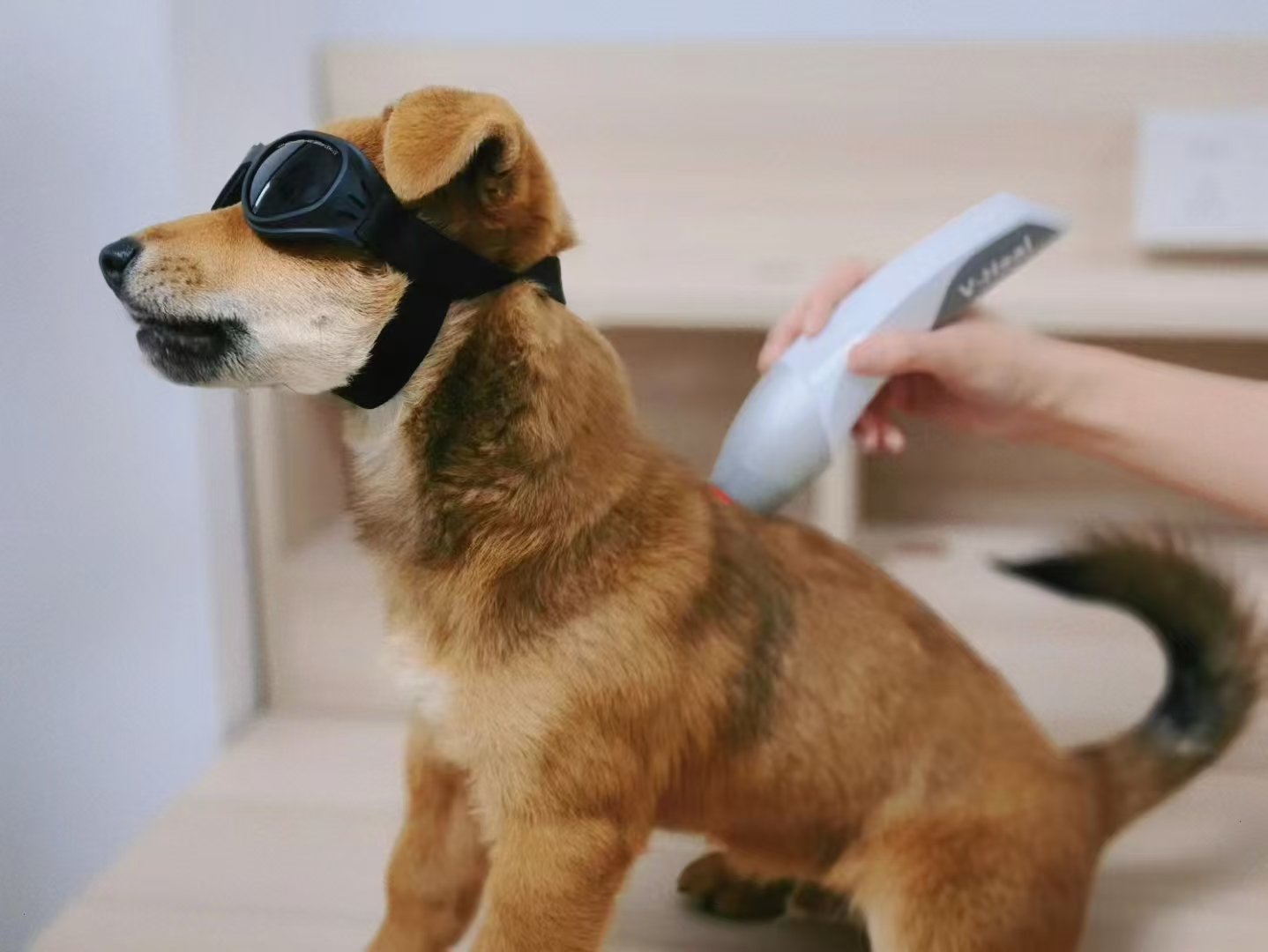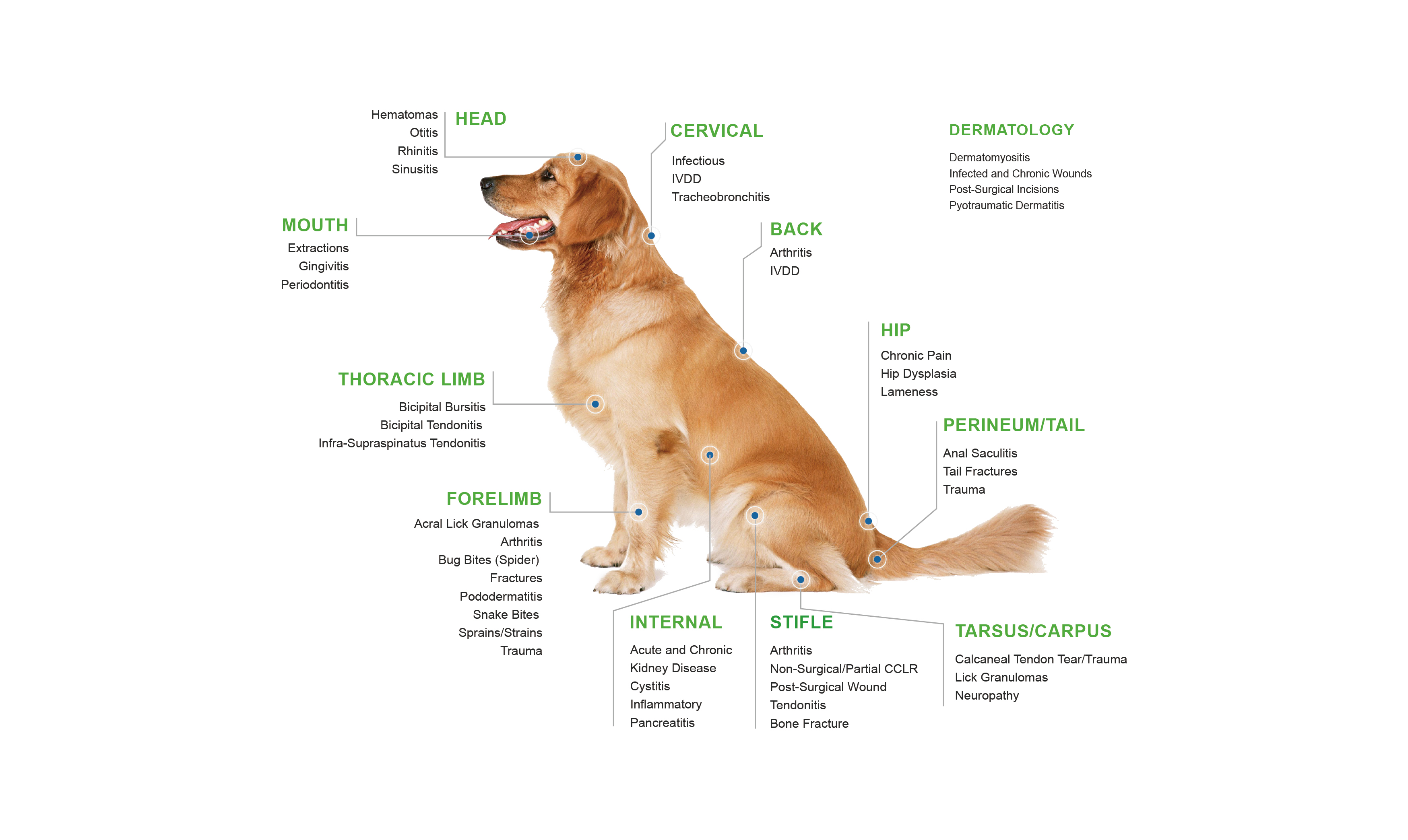Laser Therapy for Dogs - Everything You Need to Know

1. What is laser therapy for dogs?
Laser therapy for dogs is an alternative treatment modality to manage pain, reduce inflammation and edema, and promote tissue healing. The interaction between specific wavelengths of light and canine tissue is called photobiomodulation. The range of 650 to 1100 nm is called the light therapy window. In this wavelength range, light can more effectively penetrate tissue and reach the site of lesions to exert its therapeutic effect without causing excessive thermal or photochemical damage.
When dogs need laser treatment, there are usually two types of options. One is class 3 laser therapy with a power of less than 500mw, also known as low-level laser therapy (LLLT) or cold laser therapy, which is mainly used for superficial tissue treatment, such as skin wounds, muscle pain relief, etc. The other is class 4 laser therapy with a power of more than 500mw, also known as high-level laser therapy (HLLT), which is suitable for deeper tissue conditions, such as arthritis, deep muscle injuries, etc. In general, the class 4 laser has a wider range of applications, faster healing, and better treatment effects than the class 3 laser.
2. Is laser therapy for dogs effective?
Since the first veterinary laser therapy equipment was launched in 2005, it has been nearly 20 years. During this period, more and more pet hospitals/veterinary clinics have begun to introduce this advanced treatment technology and have experienced the many benefits it offers. Vaymed has now partnered with more than 1,500 pet hospitals and clinics. Through extensive clinical feedback, the broad applicability of laser therapy in veterinary clinical practice has been well established. Class 4 laser therapy is suitable for about 80% of clinical conditions, especially in reducing inflammation and alleviating pain. Laser therapy has been widely adopted and promoted by veterinary orthopedics, dermatology, and neurology, and has become one of the indispensable and important means in veterinary clinical treatment.
Although laser therapy for dogs is widely used, there are still some contraindications:
Do not aim the laser beam at the eyes
Do not use the laser on tumor sites
Do not use the laser on actively bleeding tissue
Do not use the laser to irradiate a pregnant uterus directly
Do not treat with laser therapy within 7 days after steroid or other drugs are injected into the joint area.
3. Does laser therapy for dogs work?
Musculoskeletal injuries: Laser therapy can promote the repair of canine soft tissues such as strains, sprains, and ligament damage, It accelerates the disappearance of inflammation and effectively relieves pain and muscle tension.
Intervertebral disc disease: It helps reduce inflammation and edema of the intervertebral discs, relieves symptoms such as back pain, hind limb weakness, and paralysis, and promotes the recovery and repair of nerve function.
Inflammation: In cases of dogs arthritis, tenosynovitis, pneumonia, and similar conditions, it can inhibit the release of inflammatory mediators, reduce the level of inflammation, and relieve symptoms such as joint redness, swelling, heat, and pain.
Skin injuries: It accelerates blood circulation in wounds such as abrasions, lacerations, and burns; promotes neovascularization; stimulates skin cell proliferation and migration, accelerates wound closure and promotes wound healing.
Surgical incisions: They stimulate collagen synthesis, enhance tissue repair, promote incision healing, reduce scar formation, and lower the risk of infection.
Nerve injury: It promotes the repair and regeneration of nerve cells in traumatic injury, improves nerve conduction function, and relieves nerve pain.

4. How much is laser therapy for dogs?
Laser therapy treatment for dogs usually requires a complete course of treatment rather than a single treatment, and the duration of the course depends on the severity of the disease. The cost of a single laser treatment for dogs varies depending on the local economic conditions, generally between 40USD and 80USD, and can be adjusted appropriately according to specific circumstances.
5. How to prepare dogs for laser therapy?
Most dogs can adapt well to this painless, non-irritating, non-invasive treatment method. Before laser treatment, calm the dog, position it comfortably, and do not cover the wound; during laser treatment, both the dog and the veterinarian need to wear laser goggles.
Based on the dog's condition, choose the appropriate method, contact treatment, or non-contact treatment; contact treatment is suitable for cases without skin diseases, open wounds, or incisions, while non-contact treatment is suitable for cases with skin diseases, open wounds, or incisions.
6. How many treatments are needed for laser therapy in dogs?
For most conditions, 6 laser treatments are usually enough to achieve the desired effect. The laser treatment schedule is 1 time per day, 3 consecutive laser treatments, 1 time every other day, and 3 more laser treatments. For chronic diseases (such as chronic pain, IVDD, arthritis, etc.), 12 laser treatments are generally required, 1 time per day, 6 consecutive laser treatments, 1 time every other day, and 6 more laser treatments. The exact number may be extended based on the dog’s response to laser treatment.
7. Alternatives to laser therapy for dogs
Laser therapy for dogs is effective, well-tolerated, and easy to use. It is usually recommended as part of a treatment plan, but it is not the only treatment. The following treatments can be used in conjunction with laser therapy to treat your pet's condition.
(1) Heat or cold therapy: Cold therapy can reduce inflammation and pain; heat therapy can increase blood flow, relax muscles, and promote healing
(2) Ultrasound uses sound waves to generate both thermal and non-thermal effects. It can break down scar tissue, improve muscle elasticity, enhance circulation, and relieve pain. It is often used for the rehabilitation of muscle, tendon, or bone injuries.
(3) Massage therapy includes techniques such as joint mobilization, chiropractic manipulation, and trigger point therapy. These help relieve pain, improve joint mobility, relax muscles, and enhance circulation, supporting both physical and mental well-being in pets.
(4) Hydrotherapy involves the use of underwater treadmills or swimming pools. Through water’s temperature, buoyancy, and resistance, it enables low-impact exercise, helping to relieve arthritis pain, enhance cardiovascular function, and shorten recovery time after surgery.
(5) Extracorporeal shock wave therapy involves applying short, high-intensity sound waves to targeted areas to stimulate healing. It can be used to treat arthritis, tendon and ligament injuries, fractures, scar tissue, and other musculoskeletal conditions.
(6) Acupuncture involves inserting fine needles into specific points to stimulate physiological responses. It can increase blood flow, reduce muscle spasms, and alleviate pain. Often used for musculoskeletal and neurological disorders, it is commonly combined with other therapies.
Always consult your veterinarian before choosing an appropriate alternative treatment.
8. Laser therapy for dogs FAQs:
(1) How does laser therapy for dogs work?
Also known as photobiomodulation therapy, laser therapy for dogs uses specific wavelengths of infrared and near-infrared light to stimulate target tissues. This produces beneficial photophysical and photochemical reactions, which promote healing, reduce inflammation, and relieve pain.
(2) Can I do laser therapy for my dog at home?
Yes. Devices like the V-Heal Class 4 laser therapy and Skyline Class 4 laser therapy machines, developed by Vaymed, are suitable for use at home, in clinics, and outdoors. However, it is strongly recommended to consult your veterinarian before starting home treatment.
(3) Is laser therapy safe for dogs?
Laser therapy for dogs is safe, non-invasive, and non-ionizing. It reduces risks of infection or bleeding associated with surgery. However, when using Class 4 lasers, prolonged exposure to the same area should be avoided to prevent burns. Operators must be well-trained and follow safety guidelines strictly.
References
[1] A randomized double-blinded controlled trial on the effects of photobiomodulation therapy in dogs with osteoarthritis - João C. Alves, DVM, MSc, PhD; Ana Santos, DVM, MSc; Patrícia Jorge, DVM; L. Miguel Carreira, DVM, PhD
[2] Perilesional photobiomodulation therapy and physical rehabilitation in post-operative recovery of dogs surgically treated for thoracolumbar disc extrusion - Sara Canal; Michela Antonucci; Marco Bernardini; Federica Balducci; Vincenzo Musella; Matteo Mussoni; Giuseppe Spinella








